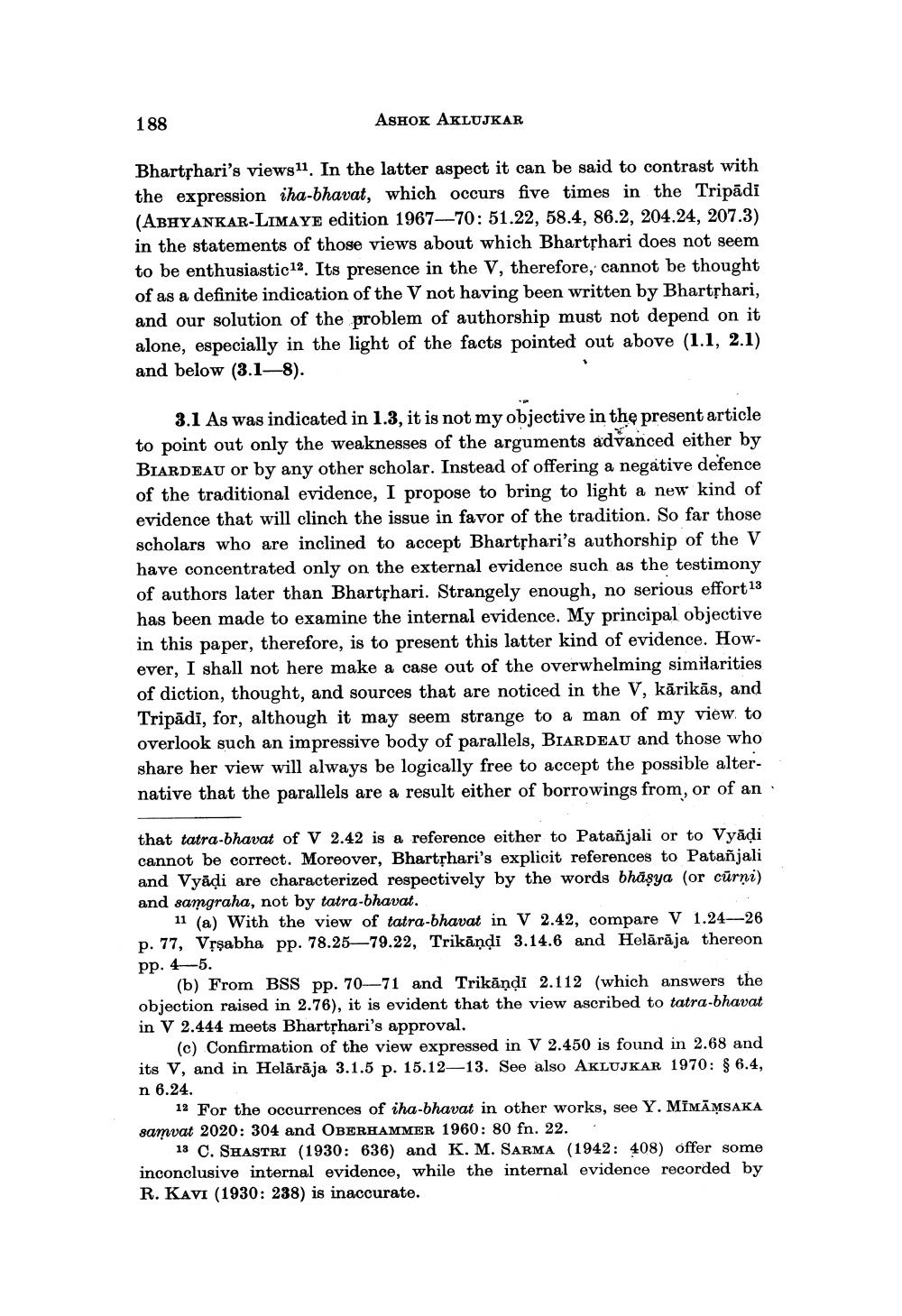Book Title: Authorship Of Vakyapadiya Vrtti Author(s): Ashok Aklujkar Publisher: Ashok Aklujkar View full book textPage 8
________________ 188 ASHOK AKLUJKAR Bhartphari's viewg11. In the latter aspect it can be said to contrast with the expression iha-bhavat, which occurs five times in the Tripādi (ABHYANKAR-LIMAYE edition 1967–70: 51.22, 58.4, 86.2, 204.24, 207.3) in the statements of those views about which Bhartshari does not seem to be enthusiastic12. Its presence in the V, therefore, cannot be thought of as a definite indication of the V not having been written by Bhartshari, and our solution of the problem of authorship must not depend on it alone, especially in the light of the facts pointed out above (1.1, 2.1) and below (3.1-8). 3.1 As was indicated in 1.3, it is not my objective in the present article to point out only the weaknesses of the arguments advanced either by BIARDEAU or by any other scholar. Instead of offering a negative defence of the traditional evidence, I propose to bring to light a new kind of evidence that will clinch the issue in favor of the tradition. So far those scholars who are inclined to accept Bhartphari's authorship of the V have concentrated only on the external evidence such as the testimony of authors later than Bhartphari. Strangely enough, no serious effort 13 has been made to examine the internal evidence. My principal objective in this paper, therefore, is to present this latter kind of evidence. However, I shall not here make a case out of the overwhelming similarities of diction, thought, and sources that are noticed in the V, kārikās, and Tripādī, for, although it may seem strange to a man of my view to overlook such an impressive body of parallels, BIARDEAU and those who share her view will always be logically free to accept the possible alternative that the parallels are a result either of borrowings from, or of an that tatra-bhavat of V 2.42 is a reference either to Patañjali or to Vyāļi cannot be correct. Moreover, Bhartshari's explicit references to Patañjali and Vyādi are characterized respectively by the words bhāsya (or cūrni) and samgraha, not by tatra-bhavat. 11 (a) With the view of tatra-bhavat in V 2.42, compare V 1.24-26 p. 77, Vrşabha pp. 78.2579.22, Trikāņdi 3.14.6 and Helārāja thereon pp. 45. (b) From BSS pp. 70—71 and Trikāņdi 2.112 (which answers the objection raised in 2.76), it is evident that the view ascribed to tatra-bhavat in V 2.444 meets Bharthari's approval. (c) Confirmation of the view expressed in V 2.450 is found in 2.68 and its V, and in Helārāja 3.1.5 p. 15.12—13. See also AKLUJKAR 1970: $ 6.4, n 6.24. 12 For the occurrences of iha-bhavat in other works, see Y. MIMĀMSAKA samvat 2020: 304 and OBERHAMMER 1960: 80 fn. 22. 13 C. SHASTRI (1930: 636) and K. M. SARMA (1942: 408) offer some inconclusive internal evidence, while the internal evidence recorded by R. KAVI (1930: 238) is inaccurate.Page Navigation
1 ... 6 7 8 9 10 11 12 13 14 15 16 17 18
